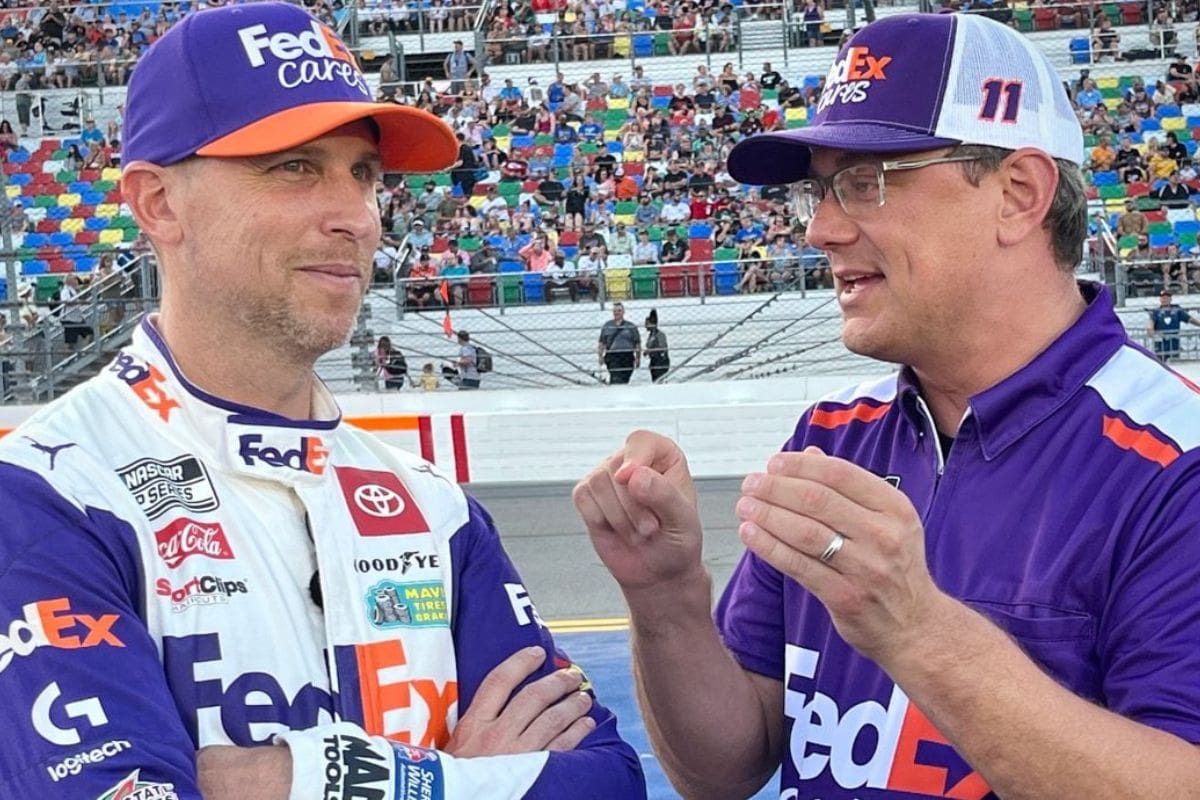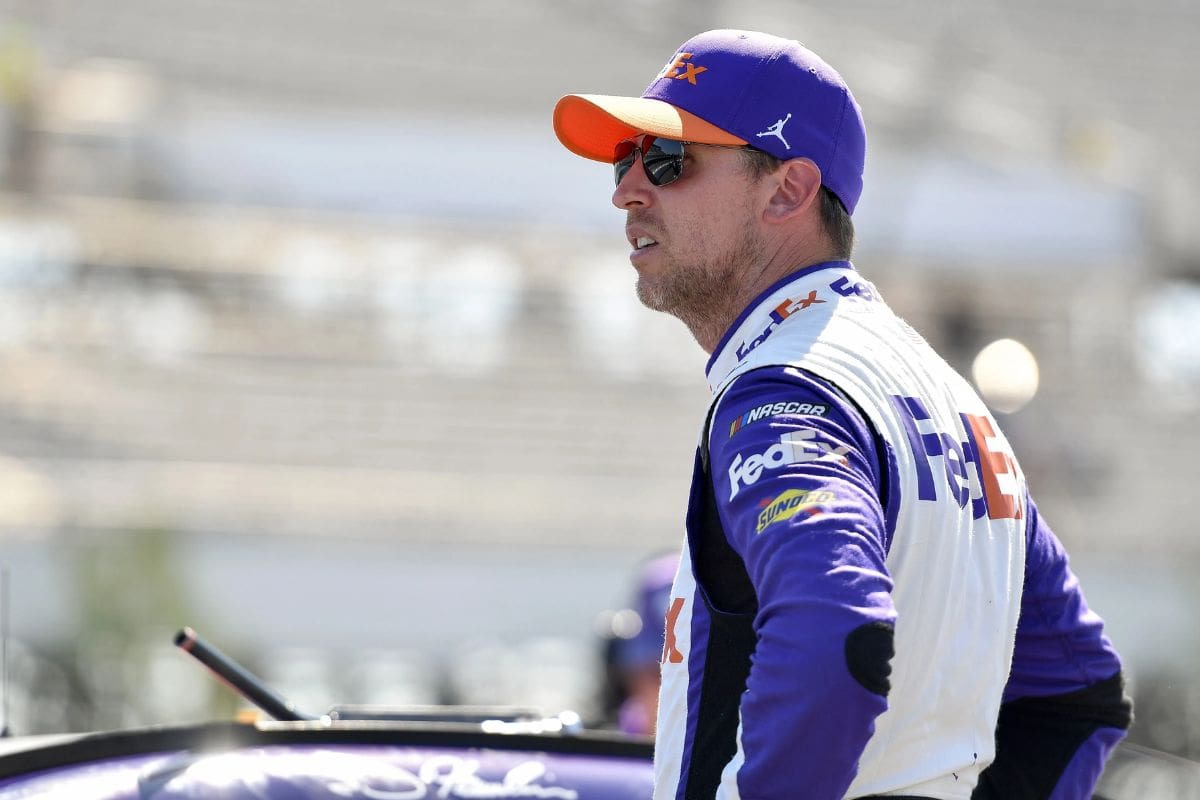Denny Hamlin and Chris Gabehart: Denny Hamlin, alongside his crew chief, confronted critique from a renowned dirt racing figure with remarkable poise, sparking widespread discussion within NASCAR’s circles. Their defense not only addressed the immediate criticism but also shed light on the broader complexities of racing strategies and sportsmanship, intertwining with NASCAR’s evolving landscape. By challenging the critique, Hamlin emphasized racing’s unpredictable nature and the necessity for adaptability, offering an enlightening perspective on managing controversies. This incident not only highlights Hamlin’s adeptness in controversy management but also prompts a reevaluation of racing principles and ethics. Exploring this further reveals layers of strategic intricacy within the sport.
Key Takeaways
- Denny Hamlin defended his controversial restart tactics, challenging critics and showcasing his racing strategy mastery.
- Hamlin’s crew chief likely supported his actions, emphasizing the competitive and unpredictable nature of NASCAR racing.
- Criticism from dirt racing legend Kevin Swindell sparked a broader debate on sportsmanship and racing integrity.
- Hamlin’s response aimed to educate on the complexities of racing strategies and rule interpretations.
- The incident highlighted the evolving dialogue on transparency and strategic complexities within NASCAR.
Setting the Stage for Controversy
Amidst the high-octane world of NASCAR racing, Denny Hamlin’s penchant for controversy has once again thrust him into the limelight, setting the stage for a contentious debate following Sunday’s race. Hamlin, a figure synonymous with the polar ends of fan and pundit opinions, has carved a niche for himself where his actions and words often transcend the race track, igniting discussions that reverberate far beyond the confines of the racing community.
This latest episode in the saga of Denny Hamlin’s career is not merely about a moment or an event; it’s the culmination of a pattern, a series of controversies that seem to shadow his trajectory. It embodies the essence of a racer who, despite his undeniable talent and accomplishments, finds himself often at the epicenter of debate. This is not incidental but rather indicative of Hamlin’s complex relationship with the sport and its stakeholders.
The controversy following Sunday’s race is symbolic of the broader discourse surrounding Hamlin. It’s a discourse characterized by a dichotomy of respect for his on-track prowess and criticism for the polarizing figure he becomes off it. This dynamic sets a precedent, suggesting that Hamlin’s actions, regardless of intent, are subject to heightened scrutiny and debate within the NASCAR community. Analyzing the layers of this latest controversy offers invaluable insights into the fabric of NASCAR racing—a world where competition, personality, and controversy are inextricably linked. Hamlin’s role in this ecosystem is both fascinating and instructive, providing a case study in the complexities of modern sportsmanship and the ever-evolving narrative of NASCAR racing.

Divide Among NASCAR Veterans
The recent controversy surrounding Denny Hamlin’s restart has sparked a notable divide within the NASCAR community, with seasoned veterans of the sport aligning on different sides of the debate. This split among the stalwarts not only emphasizes the complexity of the situation but also reflects the broader challenges of interpreting racing regulations in high-pressure scenarios.
Hamlin and his crew chief, Chris Gabehart, have found themselves at the center of this storm, attempting to navigate through the criticism while advocating for their perspective on the contentious restart. The veteran drivers’ differing viewpoints highlight a fascinating aspect of NASCAR: its evolving nature and how interpretations of the rules can vary even among the most experienced in the field. To illustrate the divide, consider the following table, which encapsulates the stance of several veterans on the issue:
| Veteran Driver | Stance on Hamlin’s Restart | Reasoning |
|---|---|---|
| Driver A | Supportive | Tactical Mastery |
| Driver B | Critical | Rule Infraction |
| Driver C | Neutral | Ambiguous Situation |
| Driver D | Supportive | Strategic Advantage |
| Driver E | Critical | Unfair Advantage |
This tableau not only showcases the divide but also invites the audience to explore further into the complexities of NASCAR racing strategies and rule interpretations. This prompts a broader discussion on the application and understanding of the sport’s regulations by its most seasoned participants, thereby enriching the discourse surrounding this controversy. The dialogue between Hamlin, Gabehart, and the veteran drivers serves as a microcosm of the larger conversations about fairness, competition, and the spirit of racing within the NASCAR community.
Dirt Racing Legend Criticizes Hamlin
In a recent and pointed critique on social media, dirt racing icon Kevin Swindell openly challenged Denny Hamlin’s integrity, accusing him of prematurely initiating a restart during a contentious race. Swindell’s accusation not only stirred the pot in the racing community but also highlighted the nuanced tensions between different racing disciplines. His critique, articulated through a medium as accessible as Twitter, emphasizes the immediacy and impact of digital platforms in airing grievances and influencing public opinion within professional sports circles.
Just saw a clip of Denny arguing about what defines the zone.
— Kevin Swindell (@KevinSwindell) April 2, 2024
Like bro. It used to be a smaller box with a line on the wall and no line on the track but dude acts like he just made an oops.
Just own it. You went early. They didn’t call it. Nothing will change. It’s not your…
Swindell’s assertion of Hamlin’s premature restart is not merely a critique of a single race incident but speaks to broader concerns about sportsmanship and the ethical boundaries within competitive racing. By questioning Hamlin’s integrity, Swindell taps into a deeper discourse about the values upheld by racers in high-stakes environments. This move by a respected figure in dirt racing to publicly call out a NASCAR veteran like Hamlin indicates a clash of racing cultures and different interpretations of what constitutes fair play.
Swindell’s criticism analysis sheds light on the complications of professional racing, where the boundaries between aggressive competitiveness and unsportsmanlike conduct frequently blur. The incident serves as a focal point for discussions about the integrity of racing tactics, the respect for unwritten rules among racers, and the role of public scrutiny in maintaining ethical standards within the sport. Furthermore, Swindell’s critique highlights the evolving dynamics of racer interactions in the digital age, where social media platforms become arenas for public accountability. This incident reflects the changing landscape of professional racing, where reputation and conduct are as much a part of a racer’s legacy as their achievements on the track. 
Hamlin’s Response to Criticism
Responding to Kevin Swindell’s pointed critique, Denny Hamlin stood firm, articulating a defense of his actions during the controversial restart and offering his perspective on the incident. The NASCAR circuit, known for its high-octane drama and intense rivalries, found itself embroiled in a new controversy that saw Hamlin at its center. His response to Swindell’s criticism wasn’t just a mere rebuttal; it was a robust defense that sought to clarify the situation from his vantage point, providing insights that only someone in his position could offer. In his defense, Hamlin highlighted three critical aspects:
- The Nature of Racing: Emphasizing the unpredictable and often chaotic nature of dirt racing, Hamlin pointed out that every action on the track is a split-second decision, subject to interpretation and scrutiny.
- The Controversial Restart: He explained his thought process and the reasoning behind his actions, which Swindell and other observers questioned.
- The Larger Context: Hamlin placed the incident within the broader framework of racing dynamics, stressing that what might seem controversial from the outside is often a calculated risk within the sport.
See this is where you not listening and instead using a clip to jump to conclusions. I was joking about what is A ZONE. Not what is THE ZONE. That clip is spliced together. And I wouldn’t treat fans like idiots unless they did what you just did.
— Denny Hamlin (@dennyhamlin) April 2, 2024
This analytical and engaging response from Hamlin serves as a demonstration of his mastery and deep understanding of racing dynamics. It challenges critics and fans alike to examine the complexity of the decisions drivers make in the heat of competition, underscoring the blend of skill, strategy, and split-second judgment that defines the sport. Through his words, Hamlin not only defends his actions but also educates the audience on the nuanced realities of professional racing, offering a masterclass in maneuvering controversy with grace and expertise.
Hamlin’s Admission on Podcast and Potential Precedent
During a candid moment on his podcast, Denny Hamlin openly acknowledged his strategic tactic to gain an advantage at the controversial restart, a revelation that sets a complex precedent for NASCAR’s future. This admission, while resolving one issue, opens Pandora’s box of potential future controversies within the sport. Hamlin’s honesty provides a rare glimpse into the calculated decisions drivers often make in the heat of competition, yet it also poses significant questions about the boundaries of competitive integrity and sportsmanship in NASCAR.
The implications of Hamlin’s admission extend far beyond the immediate controversy. It challenges NASCAR officials to reassess the clarity and enforceability of their rules regarding restarts and competitive conduct. For competitors, it sets a nuanced benchmark of what is tactically acceptable within the confines of the rules, potentially encouraging a more aggressive approach to exploiting ambiguities in the rulebook. This could lead to an escalation of strategic tactics that, while not explicitly prohibited, may skirt the edges of fair play.
Moreover, Hamlin’s openness on such a contentious issue could encourage other drivers to be more transparent about their strategies and interpretations of the rules. This trend towards transparency might foster a more open dialogue between drivers, teams, and NASCAR officials, leading to clearer regulations and a more level playing field. However, it also risks creating an environment where the line between clever strategy and unsportsmanlike conduct becomes increasingly blurred, requiring NASCAR to navigate these complex waters with a careful balance of firmness and flexibility.

News in Brief
The controversy surrounding Denny Hamlin and his crew chief’s bold response to criticism from a dirt racing legend emphasizes the complexity and diversity of opinions within the NASCAR community regarding dirt racing. Their defense not only highlights the varying perspectives on the role and value of dirt racing in the sport but also sets a potential precedent for how drivers and teams might navigate and respond to criticism publicly. This incident reflects broader debates within motorsports about tradition, innovation, and the evolution of racing disciplines.
Our Reader’s Queries
Q: What is the role of the crew chief in Nascar?
A: In NASCAR, the Crew Chief holds a role akin to that of a Head Coach. Positioned at the top of the pit box, they orchestrate pit strategy, communicate with the driver, make decisions regarding pit stops, car adjustments, and car setup, among other responsibilities.
Q: Does Denny Hamlin drive for his own team?
A: Denny Hamlin occupies a unique position among NASCAR Cup Series drivers. While he remains a driver for Joe Gibbs Racing, where he has spent his entire career, he also serves as part-owner of 23XI Racing alongside NBA legend Michael Jordan. The team’s drivers include Bubba Wallace and Tyler Reddick. Also Read: Denny Hamlin’s Easter Mishap: Fiancé Foils Weekend Plans
